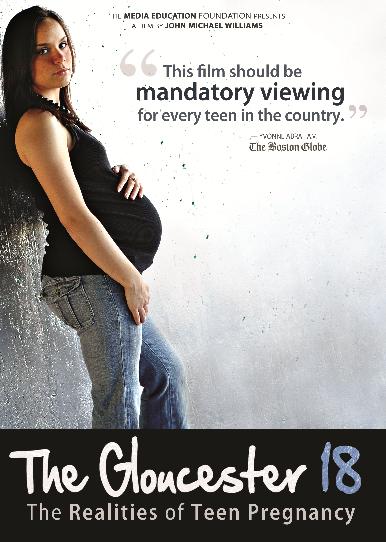The Gloucester 18: The Realities of Teen Pregnancy
Directed by John Michael Williams; produced by Kristen Grieco
Media Education Foundation
67 minutes. DVD: $195 college and university; $95 high school, community college and nonprofit.

This new documentary about a so-called “pregnancy pact,” when 18 students became pregnant at Gloucester High School in Massachusetts during the 2007-08 school year, debunks the media hype that several of the girls agreed to get pregnant and raise their babies together.
Local Gloucester Times reporter Gail McCarthy explains that her Memorial Day 2008 article, which mentioned the pregnancies but nothing about a pact, stirred the interest of Time magazine reporter Kathleen Kingsbury, who visited Gloucester to investigate. It was Kingsbury’s June 18 story that first reported a pact, sparking an international media frenzy.
Where did the pact report originate? In Kingsbury’s Time article, says Gloucester Times editor Ray Lamont in the film, “The school principal made it very clear that his perception was that a group of girls in the school were very actively trying to get pregnant.” The principal’s published declaration came as a shock to the Gloucester residents interviewed in this film, including the two school staff members most closely associated with the pregnant girls.
Dr. Brian Orr, director of the school’s health clinic, and Kim Daly, its nurse practitioner, who performed more than 150 pregnancy tests that year and counseled the pregnant students, are prominently featured in the film.
Daly’s reaction: “I read about this pact in Time magazine, and I almost fell off my chair. It’s absurd to think that anybody could possibly believe” it.
Daly and Orr are identified onscreen as former school health center staff members; halfway through the film, Daly explains that because school policy forbade them to prescribe birth control, and no other clinic was accessible, they proposed a “confidential contraceptive plan for students” to address the rise in pregnancies. In May 2008, Orr and Daly resigned after a conflict with the hospital that oversees the school clinic.
Although the film doesn’t make it clear, Kingsbury’s three June 2008 Time articles show that her only source regarding a purported pact was the school principal, Joseph Sullivan, briefly referred to but unnamed in the film. Toward the end of the film, a television clip from “Good Morning America” says, “The so-called ‘pregnancy pact’ initially reported by the principal may not be what it seems” and is not “verified by any other source.”
All the Gloucester teen mothers and their families in this film are skeptical about the existence of a pregnancy pact. “We didn’t all get pregnant at the same time,” says Kyla Brown. “It’s stupid.”
“The only pact I heard about was the girls that were already pregnant,” says Alyssa Silva, mother of teen mom Alexis. “They were going to stick together and help each other.”
Although a pact seems never to have existed, “We knew that some girls did want to get pregnant,” Orr says in the film. “In every town, you’re going to get a group of teens who are interested in getting pregnant.” As Daly puts it, “Teen moms sometimes are just really craving someone to love.” Orr reveals that “about a third” of “the Gloucester 18” had their pregnancies terminated.
This film’s deeper mission reveals how families are affected by teen pregnancy. Interviews focus on seven Gloucester teen mothers and three of their male partners, along with parents of four of the young mothers.
Among Gloucester’s population, teen pregnancy is a multi-generational fact. Alyssa Silva, teen mother Alexis’ mom, recalls her own Gloucester High School days 20 years ago, when “there were 14 girls pregnant and it was no big deal.”
Six of the film’s seven Gloucester teen mothers say they were surprised to become pregnant. Although Alivia Fidler says, “I wasn’t on any form of birth control,” she was shocked. Kyla Brown admits, “I was one of the naïve teenagers,” thinking “it’s never going to happen to me.”
Some of the fathers are older – and no wiser about contraception. Pedro Gonzalez, 21, the father of Sarah Williams’ two children, says, “I never really thought about condoms.” His half-brother Jorge Rosado, 20, knew it was wrong when he got his girlfriend Tabitha Eldridge pregnant, but “I was in love and I had a child and I wasn’t going to leave her.”
Sarah and Tabitha, each of whom has a second child, are open about their challenges as young parents. “It kind of sucks, because everyone gets to go out with their friends, and you stay home with your kids,” says Tabitha. All young parents in this film echo a similar refrain. But Sarah exudes confidence as she declares, “Everything that we have today is because of us. We work hard, and I take a lot of pride in what we’ve done together to make our family work.” The two couples share a house where they raise all four children together.
When she’s alone, Sarah reveals another motivation: She went into foster care at 13. “I wanted to start my own family and have something nobody could take away from me,” she says.
All five adult parents interviewed are supportive of their children and their children’s babies. Kim Mackey makes it clear that her daughter Brianne and the baby’s father, Michael Mitchell, “aren’t living off the state.” Michael works full-time and Brianne works part-time; they are interviewed together, enjoying their baby.
As expectant mother Kyla, 17, and her parents Wendy and Corey engage in good-natured banter, it’s obvious that Kyla is secure in their support. When Kyla is interviewed alone, she confesses that it’s nice to know that “Mummy will come and help me no matter what happens, and my dad will do the same.”
Hallie Allison’s background and her relationship with her single mother, Nancy, are more complicated. Nancy is convinced that Hallie was “hell-bent on getting pregnant.” Hallie admits that she “didn’t do anything to prevent it.” Only near the end of the film do both Nancy and Hallie, interviewed separately, reveal that violence haunts them. The husband of Hallie’s mentor, Catherine, murdered Catherine and then shot himself when Hallie was staying with them. “That blew her world apart,” says Nancy. “It did impact her decision to make her own family.” Having had one daughter at 16, Hallie is expecting another. She matter-of-factly reports that her baby’s father choked her and broke her nose “in front of my daughter.”
Then Nancy describes how her own abusive lover shot himself in the room next to her and Hallie. After Nancy confides that she blames herself for not being able to help Hallie recover, onscreen text informs viewers: “Six hours after this interview, Nancy Allison attempted suicide.” An onscreen update at the end says that Nancy married her third husband on a Gloucester beach.
As the sun sets beyond Gloucester’s fisherman statue, the screen’s last words appear: “750,000 teens in the United States become pregnant each year. The U.S. has the highest teen pregnancy rate of any developed country in the world.” (800) 897-0089, www.mediaed.org.
Cathi Dunn MacRae, former editor of Voice of Youth Advocates (VOYA), specializes in teen writing and reading. She can be contacted at CMacrae@youthtoday.org.































